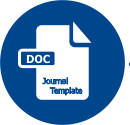Pengembangan Cookies Non Terigu dari Campuran Tepung Beras, Tepung Tapioka, dan Tepung Maizena
DOI:
https://doi.org/10.12928/jfc.v2i1.1186Keywords:
cookies, non terigu, tepung beras, tepung maizena, tepung tapioka, teriguAbstract
Pemanfaatan tepung yang sering dijumpai di dapur seperti tepung beras, tepung tapioka, dan tepung maizena hanya sebatas pengolahan tunggal pada olahan sederhana. Tujuan dari penelitian ini adalah menentukan formulasi dan perbandingan tepung beras, tepung tapioka, dan tepung maizena sebagai bahan baku cookies. Selain itu, penelitian ini bertujuan untuk menganalisa kandungan gizi dan nilai kalori cookies no terigu tersebut.Â
Desain penelitian menggunakan rancangan acak lengkap 3 kali ulangan dengan faktor perbandingan tepung beras, tepung tapioka, tepung maizena. Cookies yang dihasilkan selanjutnya dianalisa sifat kimianya antara lain analisa kadar air, kadar protein, kadar lemak, kadar abu, kadar karbohidrat, dan kadar serat kasar. Data dianalisis secara statistik menggunakan annova. Apabila hasil yang diperoleh ada beda nyata, maka dilanjutkan dengan uji DMRT dengan tingkat signifikasi 5%. Cookies yang dihasilkan juga dihitung nilai kalori per sajiannya.
Cookies berbahan baku campuran tepung beras, tepung tapioka, dan tepung maizena memiliki kadar abu, kadar lemak, dan nilai kalori yang sesuai dengan Standar Nasional Indonesia produk sejenis yaitu biskuit. Sedangkan kadar protein, kadar serat kasar, dan kadar karbohidrat belum sesuai dengan Standar Nasional Indonesia biskuit. Formulasi cookies yang dipilih berdasarkan kandungan kimia cookies yaitu campuran tepung beras, tepung tapioka, dan tepung maizena dengan perbandingan 65:30:5 karena memiliki kadar protein paling tinggi.
References
Ana C. B. L., A. J. G. Pereira dan R. Gonçalves. 2004. “Flour Mixture of Rice Flour, Corn and Cassava Starch in the Production of Gluten-Free White Breadâ€, dalam Brazilian Archives of Biology and Technology. Volume 47. No 1, 2014, 63-70.
Anonim-a. 2015. Statistik Konsumsi Pangan Tahun 2015. Jakarta: Pusat Data dan Sistem Informasi Pertanian, Sekretariat Jenderal, Kementrian Pertanian.
Anonim-b. 2015. Laporan Akhir: Kajian Efektivitas Kebijakan Impor Produk Pangan dalam Rangka Stabilisasi Harga. Jakarta: Badan Pengkajian dan Pengembangan Kebijakan Perdagangan Kementerian Perdagangan.
Giuberti G, Fortunati P, Cerioli C, Gallo A. 2015. “Gluten Free Maize Cookies Prepared With High-amylose Starch: In Vitro Starch Digestibility and Sensory Characteristicsâ€, dalam J Nutr Food Sci. Volume 5, 2015, 424-428.
Luh, B. S. dan Yuan-Kuang Liu. 1980. Rice Flour in Baking, in Rice: Utilization. New York: Van Nostrand Reinhold.
Montes, Simone de Souza, L. M. Rodrigues, R.C.V. Cardoso, G.P. Camilloto, dan R.S.Cruz. 2015. “Tapioca and Rice Flour Cookies: Technological, Nutritional, and Sensory Propertiesâ€, dalam Cienc. Agrotec., Lavras. Volume 39 No 5, 2015, 514-522.
Rai, S., A. Kaur, dan B. Singh. 2014. “Quality Characteristics of Gluten Free Cookies Prepared From Different Flour Combinationsâ€, dalam J Food Sci Technol. Volume 51 (4), 2014, 785-789.
Risti, Y. dan A. Rahayuni. 2013. “Pengaruh Penambahan Telur terhadap Kadar Protein, Serat, Tingkat Kekenyalan dan Penerimaan Mie Basah Bebas Gluten Berbahan Baku Tepung Komposit (Tepung Komposit: Tepung mocaf, Tapioka dan Maizena)â€, dalam Journal of Nutrition College. Volume 2 No 4, 2013, 696-703.
Smith, W. H. 1972. Biscuit, Crakers and Cookies. London: Applied Science Publisher Ltd.
Sultan, W. J. 1969. Practical Baking. New Jersey: Wiley.
Downloads
Published
Issue
Section
License
Authors who publish with JOURNAL OF FOOD AND CULINARY agree to the following terms:
- All articles published are Open Access that means they will be immediately and permanently free for everyone to read and download. We use the CC-BY-SA license options under Creative Commons Attribution License (CC BY-SA 4.0). Creative Commons Attribution License (CC BY-SA 4.0). CC-BY-SA assures that all works will be available under CC-BY-SA always and no risk of commercial actions against the will of the copyright holder.
- Anyone can use, copy and disseminate the material in any medium or format; as well as re-use, re-mix, transform, and build upon the material for any purpose, even commercially. However, they must acknowledge the authors by giving appropriate credits (cite to the article or content), provide a link to the license, and indicate if changes were made and use under the same license as the original.
- Authors retain copyright and grant license exclusive rights in their article to Universitas Ahmad Dahlan as publisher of the JOURNAL OF FOOD AND CULINARY.
- Authors have the right to retain patent, trademark and other intellectual property rights (including research data).
- Authors have the right to proper attribution and credit for the published work.
Copyright Transfer Agreement
- The Authors submitting the manuscripts do so on the understanding that if they are accepted for publications, copyright of the articles shall be assigned to Universitas Ahmad Dahlan as publisher of the JOURNAL OF FOOD AND CULINARY.
- Universitas Ahmad Dahlan as publisher of The JOURNAL OF FOOD AND CULINARY, the Editors, and the Editorial Board Members of the JOURNAL OF FOOD AND CULINARY make every efforts to ensure that no wrong or misleading data, opinions or statements are published in the journal. In any way, the contents of the articles and circulars published in the JOURNAL OF FOOD AND CULINARY are the sole and exclusive responsibility of their respective authors and advertisers.
- The publisher may revoke the publication for violating the ethical code of conduct.





